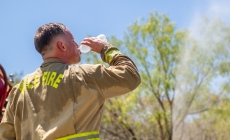-
Summer heat is coming. A new interactive tool can help you - April 25, 2024
-
A portion of Mulholland Drive, damaged by mudslides in winter storms, reopens - May 26, 2024
-
‘Maybe You Don’t Want to Win’ - May 26, 2024
-
Donald Trump Putting Law Enforcement in Danger: Attorney - May 26, 2024
-
Avoid the waters of these 5 L.A. County beaches this holiday weekend, public health officials say - May 26, 2024
-
Bawdy Comedy ‘Anora’ Wins Palme d’Or at Cannes Film Festival - May 26, 2024
-
Map Shows Heat Wave Zone Spread Into Five New States - May 26, 2024
-
Azusa police arrest suspected slingshot-wielding vandal - May 25, 2024
-
Donald Trump Hammers Judge Ahead of Jury Instructions - May 25, 2024
-
Sometimes U.S. and U.K. Politics Seem in Lock Step. Not This Year. - May 25, 2024
Summer heat is coming. A new interactive tool can help you

Despite the cooler temperatures across Southern California, the summer heat is just months away and a new interactive tool is available to help you assess how the impending high temperatures can affect your health and suggest steps to take avoid heat-related illnesses.
Due to climate change, hot weather is lasting longer and happening more frequently, said Dr. Aaron Bernstein, director of the Centers for Disease Control and Prevention’s National Center for Environmental Health and the Agency for Toxic Substances and Disease Registry.
Talking about the summer heat with “anyone who has been alive for more than a couple of decades” will typically generate the response, “It is hotter than I remember it,” Bernstein said.
The European Union’s Copernicus Climate Change Service said 2023 was the Earth’s hottest year on record, with seven consecutive months of above-average temperatures.
Hotter temperatures can result in heat-related illnesses, and if left untreated, it can lead to death. A recent CDC report found that daily emergency department visits because of heat-related illness in 2023 peaked in several regions.
To help you prepare for the future high temperatures, the CDC and the National Oceanic and Atmospheric Administration’s National Weather Service have collaborated to create an interactive online tool to help you understand how the heat in your area can affect your health and what you can do to protect yourself. The tool’s availability has been expanded to 48 states in the U.S.
Understanding heat and health
HeatRisk is an online dashboard that enables users to check the seven-day forecast according to their ZIP Code. Instead of temperature degrees, the forecast uses a five-level color scale to indicate the health risk imposed by the heat, taking into consideration heat exposure and the role of humidity in the air.
The five colors are green (no risk), yellow (minor risk), orange (moderate risk), red (major risk) and magenta (extreme risk).
What separates HeatRisk forecast from other heat-related indicators such as the National Weather Service’s HeatRisk Prototype and heat index is that it combines all of the temperature, air quality and humidity information from previous tools to provide users with actionable guidance to deal with the health risk of rising temperatures.
The tool will help you answer questions such as:
- Is it too hot to participate in an outdoor activity? An outdoor activity can be a hike, sport event or running.
- If I have a chronic medical condition, could I be more sensitive to heat exposure?
Hotter temperatures can lead to heatstroke, heat exhaustion, heat cramps, sunburn or heat rash, according to the Los Angeles County Public Health Department.
People who are at greatest risk for heat-related illness include infants and children up to 4 years of age, people 65 and older, people who are overweight and people who are ill or on certain medication, according to the CDC.
“For example heart disease, we know that many of the medications that are used to treat high blood pressure can also make people more sensitive to heat.” Bernstein said.
Red indicator or higher
When the HeatRisk tool displays a particular risk for the day and the rest of the week, it also shares actions the user can take to protect their health.
As of Wednesday, the tool says there is little to no risk in Los Angeles, but on Saturday, a slight uptick in temperature raises the risk to the “minor” level. The suggested actions are staying hydrated and cool.
The goal of the tool, Bernstein said, is that users will either take precautions during hotter days and, if needed, work with their doctor to come up with a plan to prepare for high-temperature days, particularly for people with medical conditions.
For example, someone with a chronic medical condition should take extra precautions during a heat wave such as remain in a room with air conditioning. If that person doesn’t have air conditioning, they should make a plan to be in a cool indoor area, he said.
The tool isn’t just for vulnerable populations. Everyone should be taking their heat risk into account, especially when the indicator is showing the risk is major (red) or extreme (magenta), said Kimberly McMahon, program manager for the National Weather Service’s public weather services.
The information can be used by city officials and community organizations to start preparing to “hand out bottles of water or potentially open up cooling shelters,” McMahon said.
Heat safety reminders
Most people plan for hazards that can occur during the winter and natural disaster events. McMahon advises people to plan for the heat as well.
That plan should include having enough drinking water available and a cool place in the house or apartment building.
If a cool place at home isn’t possible, or the home does not have air conditioning, McMahon and Bernstein suggest finding cool places that are open to the public, such as libraries, malls and cooling centers.
During these hotter days, make a plan of whom to check-in with and have someone to check on you. There are members of the community — family, friends or neighbors — who might be immobile or don’t have access to transportation and are in need of assistance.
On top of staying cool and hydrated, people should be aware of the signs and symptoms to the onset of a heat-related illness, such as muscle cramping, heavy sweating, shortness of breath, dizziness, headaches, weakness and nausea, Bernstein said.
The Los Angeles County Public Health Department has a comprehensive list of heat-related illnesses, their specific symptoms and what to do if someone is having symptoms.
Some other tips for staying cool are:
- Eat foods with high-water content, such as watermelon and cucumbers, but limit or avoid sugary, alcoholic and caffeinated drinks.
- Wear loose, light-colored clothing and hats for protection.
- Keep your pets indoors if possible. If you have to keep them outside, make sure they have plenty of shade and water.
- Take a cold shower.
- If possible, avoid using your stove, oven or other appliances that generate heat.
The national agencies are taking feedback on the new tool. Users can share their experience by filling out this online survey.
Source link































